Movie Review – Star Wars: Episode I – The Phantom Menace
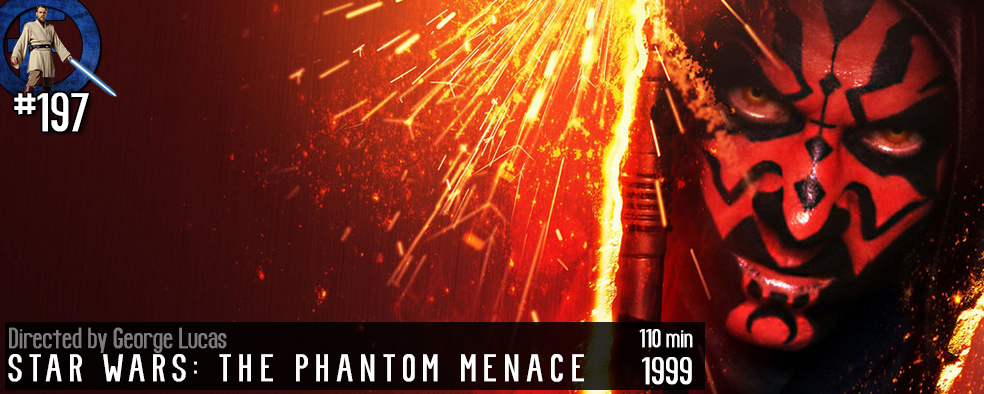
Cast : Ewan McGregor, Liam Neeson, Natalie Portman, Jake Lloyd, Ian McDiarmid, Anthony Daniels, Kenny Baker, Pernilla August, Frank Oz, Ahmed Best, Brian Blessed, Oliver Ford Davies, Hugh Quarshie, Samuel L Jackson, Ray Park, Keira Knightley, Silas Carson.
Synopsis: Opening stanza in the Star Wars saga sees the introduction of Obi-Wan Kenobi, Anakin Skywalker, and a bunch of other characters with whom we quickly grow tired.
*******
Reinventing the Wheel: Reproducing Star Wars Magic?
When George Lucas re-released his beloved Star Wars trilogy to cinemas in 1997, remastered and featuring new footage reinserted, fans were divided: the added material was sharper, cleaner and newer than what had gone before, and was a little disconcerting in the difference of textural quality between the old and new. The narrative aspect of the new material was of more concern, with many feeling that the added footage (especially in A New Hope) detracted from what was considered to be a classic film. Lucas came under fire from some quarters for his haphazard additions, but he persisted, instead trying to satiate fans with the announcement that a new trilogy of Star Wars films would be made, with the first to debut in 1999. This, as you can imagine, sent the geek world and fandom off into an orgiastic frenzy of speculation and fantasy. I admit, I too was among the many who desired to see new Star Wars adventures (that weren’t hokey Ewok-inspired TV movies) up on the big screen, and I applauded Lucas for finally conceding to fan demand to do so. Around this time, I think, Lucas stated publicly that Star Wars was only ever intended to be a 6 part saga, not a 9 episode pulp-serial as was thought in the early days. For years, fans had wondered about the history of Vader, Obi-Wan and the rest, all only ever expanded by the dialogue in the three films, which was a finite amount of information. Now, though, the reality was about to be told, and finally, we’d get the “authorised” history of these beloved characters in full cinematic glory.
But I was left with the tingling feeling of those that are a little dubious about the reality of doing it…. is it to really enhance the story, or is it for something more…. like money? Honestly, I hoped Lucas could do the saga justice. The first three films, admittedly the second and third were directed by other people, had been mega-hits, and were firmly entrenched in the pantheon of cinematic greatness, such was their standing in film lore. Now, Lucas was embarking upon the storytelling venture himself, directing all three films and doing it exactly the way he wanted. The fan base was excited: after all, it had been nearly two decades since the last Star Wars feature had been released, and people were keen to see new adventures set in the same universe as Luke & Leia.
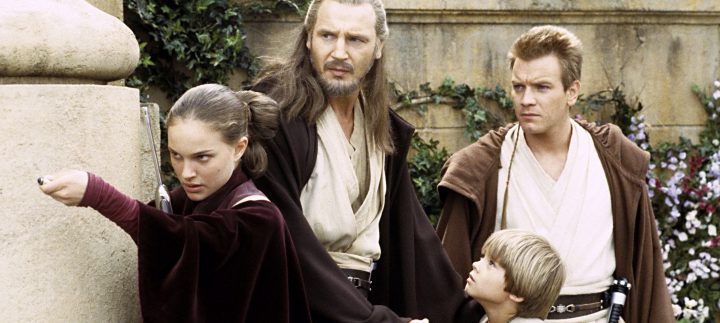
It’s of little consequence that the hype surrounding The Phantom Menace’s creation was perhaps the single greatest event in cinematic history, from the announcement, to the premiere of the first teaser trailer, to the gargantuan world-wide release of the film in May of 1999. All the hype in the world wouldn’t make it a better film if the film itself was a turkey. Of course, some kind souls indicated that no matter how good the film was, it was never going to live up to the massive hype and rose-tinted glasses looking back at the original trilogy; there was no way Lucas could hope to rekindle the glorious wonder of encountering Yoda for the first time, seeing Vader stride into frame, or the scintillating thrill of a lightsabre battle on the big screen. Surely, he’d just have to hope and pray people accepted his view of what he intended with his own creations. Internet websites buzzed, news corporations poured plenty of ink and web-space into the Star Wars phenomenon, all building the buzz for what was, perhaps, going to be the single greatest film event of our time.
The Phantom Menace
The fourth film to be made in the Star Wars canon, and first film chronologically, The Phantom Menace opened theatrically to a blaze of publicity and hype. And fizzled just as much…. at least critically. Disembowelled critically as heavy handed, a waste of time, and crapping all over the precious Star Wars legacy, The Phantom Menace stands tall as one of those films that has unprecedented anticipation and hype that it cannot possibly live up to, only to fall over when analysed critically.
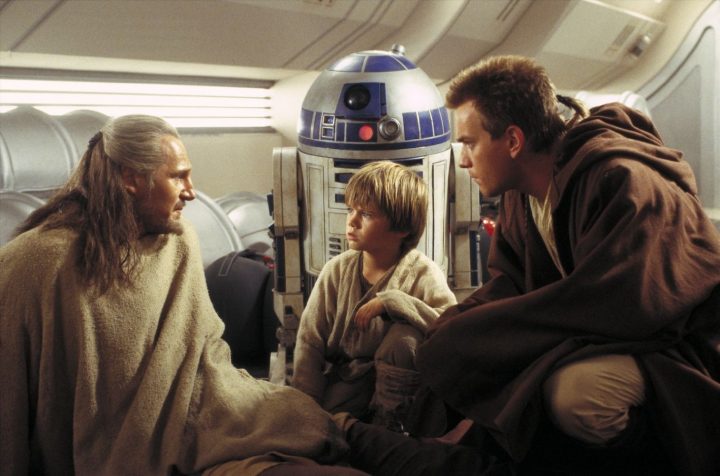
Essentially, The Phantom Menace starts the Star Wars story from the very beginning… before Darth Vader and Luke Skywalker, there was Obi Wan, Queen Amidala, and Jar Jar Binks. (More on Binks later folks, it’s okay.) George Lucas, the master of all things in the Star Wars universe, decided to utilise the developing computer digital technology to film his latest opus, the “first” three films in his saga. Lucas had long stated that the original trilogy, comprising of A New Hope, The Empire Strikes Back, and Return Of The Jedi, was actually part of a larger story, consisting of 9 parts. Later, he would revise that statement to be 6 parts, and in late 99, The Phantom Menace became a reality for millions of hard-core Star Wars fans around the globe.
The planet of Naboo is under siege by the malevolent Trade Federation, and when a couple of Jedi Knights are sent to investigate and negotiate a truce, they are attacked and forced into action. The Jedi, Qui-Gon Jinn, and his padawan learner Obi Wan Kenobi, discover that the Trade Federation have decided to invade the planet, which goes against their charter and the Republic’s wishes, and have to find a way to escape the planet to warn people. In doing so, they encounter a strange resident of Naboo, Jar Jar Binks, a baby-talking Gungan who is clumsy, hard to understand, and most bafflingly, the unfunniest comedy relief ever devised for a film. A series of events that transpire force Obi-Wan and Qui-Gon to travel to Tatooine, the home of one Anakin Skywalker, a young slave child living with his mother. Anakin shows a great deal of connection with the Force, and as Qui-Gon explains, his Midichlorian count is exceptionally high, meaning that Anakin could grow up to be quite a powerful Jedi with the right training. More on the Midichlorians later, folks. Plenty to say about them.
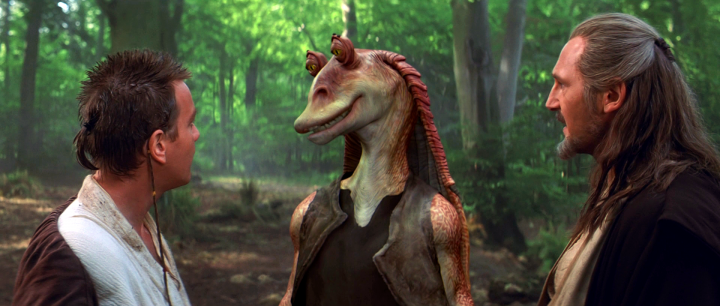
When Qui-Gon win’s Anakin from his slavery by allowing him the chance to win a fast-paced Pod-race across the desert of Tatooine, Anakin’s destiny is changed forever as he accompanies the two Jedi back to Coruscant, the seat of power for the Galactic Republic in the universe. Here, at the headquarters of the Jedi, the council of Jedi reveal that Anakin is too old to receive training to become a Jedi, something which doesn’t sit well with Qui-Gon. In a desperate bid to halt all-out war on Naboo, the Jedi council send the two Jedi and their young charge back to the planet to effectively stem the Trade Federation’s invasion using whatever means necessary. During the course of this conflict, Qui-Gon and Obi-Wan engage in a three-way battle with Sith Lord Darth Maul, culminating with the demise of Obi-Wans master. Anakin, meanwhile, (bearing in mind he’s only about ten years old) flies a ship up to the Trade Federation control ship, to escape ground attention by the invading army. He succeeds in destroying the ship single-handedly, drawing the respect of the Jedi, including Yoda and Master Windu (Sam Jackson), who recant their original statement that Anakin will not be trained to be a Jedi. Obi-Wan takes Anakin as his padawan learner, and the start of the saga begins…
There’s plenty to enjoy about The Phantom Menace, if I was to be honest. Well, plenty I wanted to enjoy, that is. First, it’s good to hear John Williams brilliant theme for the series again reproduced in full THX Dolby, and I have to say this is a return to form for the man since his more lacklustre turns in years since ’93, when he scored Jurassic Park. His tumultuous choral work in Phantom Menace is one his best works since Return Of The Jedi. The lightsabre fights in Phantom are truly extraordinary, the two-bladed Darth Maul version going toe-to-toe with two highly trained Jedi Knights in an amazingly athletic, extraordinarily choreographed dance of death. The sense of fun we saw in the three original films is, however, lacking, and this casts a pall on what would otherwise be a fairly benign, entertainment-free film.
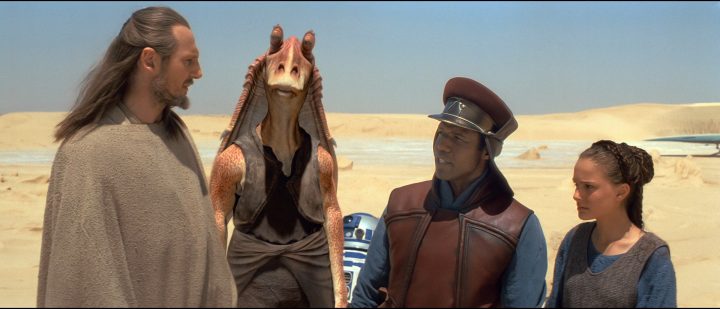
I will pause here, though, and completely retract that statement for the briefest of moments, when referring to the film’s central show-piece, a stunning, twenty minute race through the Tatooine desert by Anakin and other competitors in a podrace. Filmed like the Ben Hur chariot race, this stunningly done, brilliantly visual action sequence, with Anakin desperately battling arch-rival Sebulba (another of Lucas’ digital characters) as they sit in tiny capsules powered along by massive engines and jet propelled through the landscape at impossibly frightening speeds, is vintage Star Wars. Here, for a few exhilarating moments, The Phantom Menace truly does shine. The editing, the pacing, the effects, the music, the sound: all components of the film click into place to generate real tension and excitement, something the film desperately needed. Unfortunately, this sense of occasion doesn’t last.
Where I think Lucas went horribly wrong with Phantom Menace, and with all three prequel films, is his overuse, or over-reliance, on the digital effects he was employing to tell the story. Instead of the realistic, grimy, gritty nuances of people on sets we had with the original three films, here, we get people running about on green-screen platforms acting to balls on a stick. Yes, the dreaded green-screen, the only product in the world that can suck the realism from a performance quicker than Jessica Simpson at an IQ Test Convention. Whereas the actors in the original trilogy could maintain a performance due to the fact that they were standing in a real location or set, reacting to the world around them, dealing with live-action beings and not a bunch of artificially created, CGI creatures who “will be added later”, the performance level then is vastly superior to now. That’s not to say that the cast, and it’s a pretty decent cast, are badly done by in terms of performance. Liam Neeson and Ewan McGregor give their all, as does young Jake Lloyd, who is badly let down by some woeful scripting and hamfisted direction from Lucas. The poor boy doesn’t quite have the tenacity to play the character of Anakin, a youthful, soulful, inquisitive boy who will one day grow up to rule the galaxy. Instead, Lucas seems intent on casting Lloyd purely on looks and commercial viability, more cutsey-munchkin than potential Vader. There should have been a hint of darkness about him. There isn’t. Neeson and McGregor paddle their way through some truly uninspiring and hokey dialogue themselves, trying desperately to imbue Lucas’ vision with the thunderous emotive weight it deserves. But Lucas’ inability to craft a decent dramatic curve in his film ensures that no matter how much gravitas you put into a line, or anguished you look towards the camera, ultimately, it feels forced, and that’s not a good sign for a film.
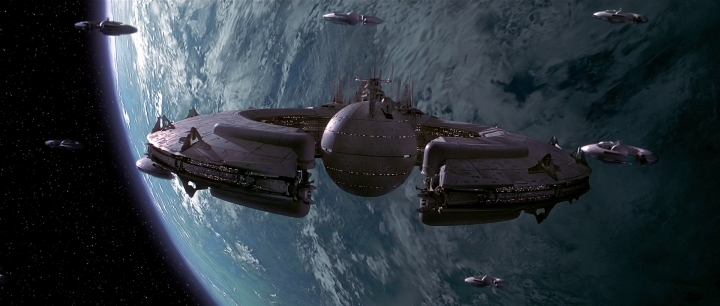
It’s hard to criticise this film, and the two others in the prequel trilogy, without comparison to the original films. After all, the original trilogy has generated a following bordering on cultish, and a mythic status of unrivalled excellence as cinema. Essentially, the pulp origins of the saga underscore the original trilogy so well people almost tend to overlook their humble origins. Here, it’s alike Lucas has cast the pulp aside and tried to make the characters more mainstream, more “Event Film”, and it’s the wrong direction to take.
Then, of course, there is Lucas insistence on tearing down the science of the Force. Apparently, according to a scene within Phantom Menace that has caused much consternation and gnashing of teeth among fans, the Force is really just a bad fungal infection of some kind. Midichlorians, which are a symbiotic life form that exist within all creatures in the universe, are apparently what drives the Force. In A New Hope, Obi-Wan describes to a young Luke Skywalker that the Force is “an energy field that binds the universe together.” No mention there of tiny bacteria living inside us that makes us one with the Force. Fan outrage prevented Lucas from using this term again, and it was never mentioned in any of the other Star Wars films. But the damage had been done. In one scene, Lucas had managed to undo the work he’d done in the original trilogy in building up the Force as something not everybody had, or at least, had control over. He’d stripped it down from a mystical power in tune with the universe and made it into a clinical, medical diagnosis, thus relegating the “ooo ahhh” moments in A New Hope to nothing more than unblemished ignorance. We’d been gypped.
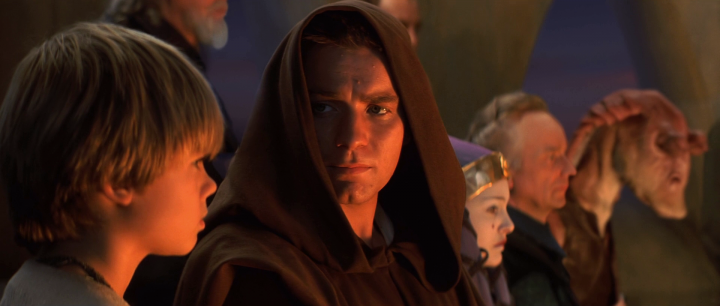
But by far the biggest caveat with Phantom Menace is Jar Jar Binks. Voiced and performed by American born Ahmed Best, and then replaced by a completely digital computer generated character, Binks came to represent all that was horribly wrong with Lucas’ new vision for his world. As a clumsy, baby-voiced creature from an underwater race on Naboo, Jar Jar was an annoying plot device who Lucas thought could possibly replace C3PO and R2D2 as the comedy relief in the new films. After all, nobody wanted to see the two robots from the original trilogy back again, did they? Sure they did, and saw Jar Jar as a poorly conceived, badly executed, and utterly contrived character which reduced the Star Wars legacy to that of a children’s film. And although the original trilogy had been classified as a younger-audience cinematic styling, adults had been able to appreciate the themes and events within then, ensuring a wider fan base develop. With Phantom, this was not to be the case. The dialogue is so banal, the events and characters so artificial and generically sci-fi, adults will quickly tire of it all. Children will lap it up, all the bright colours and cool effects, but the story doesn’t hold enough weight with it’s themes to ensure a consistent narrative throughout, and will put a lot of older fans off. Lucas spared us more Jar Jar in the next two films, thankfully, by reducing the character’s screen time to walk-on moments. I pity poor Ahmed Best, who must surely go down in history as one of cinema’s greatest character failures, and focal points of fan-based hatred. Rightfully so, but then, I lay the majority of the blame for this character purely on Lucas, and his back-door commercial interest in toy sales and merchandising. After all, the only real reason these films were made was so Lucas could skim another billion dollars or so off the fanbase, right?
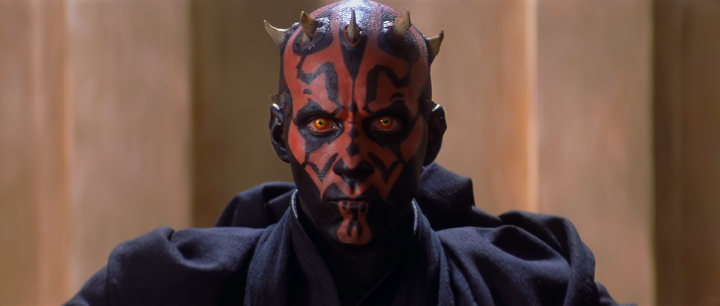
The artificiality running rampant through the film is truly shameless. The effects range from good, to great, to average at best, and you get the sense that the poor effects people were continually going back to Lucas and being told to “push it further”, and failing. Unfortunately, George, your vision is now reduced to hi-definition pixelisation and artificiality, something the original trilogy didn’t have. The acting is, at times, atrocious, and while I can’t see Liam Neeson putting in a bad performance on his own, I have to lay the blame of the stodgy dialogue squarely at the man who wrote the script. Oh wait, was that George? Well then, George it is. Woeful. Why we needed to see the childhood Anakin running about is a little tenuous to me: after all, we don’t see Luke and Leia in their nappies in the original trilogy, and we all know them so well now. In Lucas’ defence, I guess he was trying to give us a lot more of the backstory than we really needed to see, a completists wet-dream, of sorts, and if this is Lucas’ idea of recompense for making us all wait for a decade or so between films, then perhaps he should never have filmed the prequels in the first place.
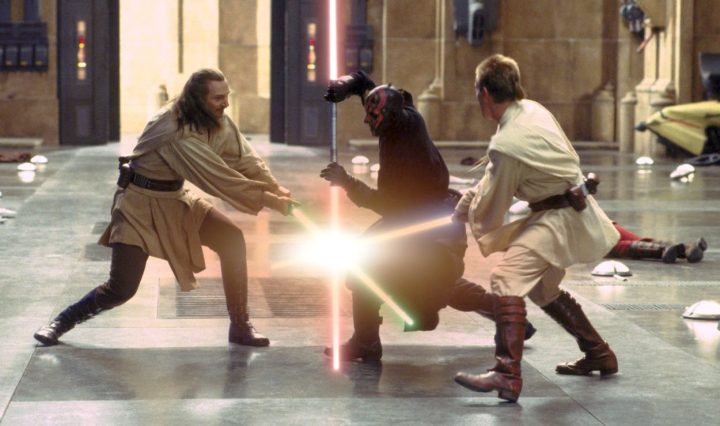
Given the massive sense of let-down when this film debuted, it cast into serious doubt the potential for the other two films in the planned series of prequels to return the franchise to form. Lucas had done himself great harm critically (although, as it turned out, not financially) and only time would tell if he could rebound and knock one out of the park.
